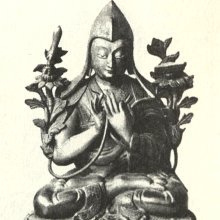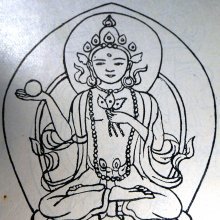Kha: 31 definitions
Introduction:
Kha means something in Hinduism, Sanskrit, Buddhism, Pali, the history of ancient India, Marathi, Jainism, Prakrit, Hindi, biology. If you want to know the exact meaning, history, etymology or English translation of this term then check out the descriptions on this page. Add your comment or reference to a book if you want to contribute to this summary article.
Images (photo gallery)
In Hinduism
Ayurveda (science of life)
Rasashastra (Alchemy and Herbo-Mineral preparations)
Source: Google Books: The Alchemical BodyThe void, the empty space of the heart, suṣumṇā-nāḍī, or cranial vault, is also termed kha—hole, cavity, empty space—whence statements in hathayogic sources concerning the free-floating state of th emeditative mind, intellect, or consciousness in the ether: this is khecara, “moving in the ether”.
Unclassified Ayurveda definitions
Source: gurumukhi.ru: Ayurveda glossary of termsKha (ख):—Akaśa; Space, synonym of Srotas

Āyurveda (आयुर्वेद, ayurveda) is a branch of Indian science dealing with medicine, herbalism, taxology, anatomy, surgery, alchemy and related topics. Traditional practice of Āyurveda in ancient India dates back to at least the first millenium BC. Literature is commonly written in Sanskrit using various poetic metres.
Vyakarana (Sanskrit grammar)
Source: Wikisource: A dictionary of Sanskrit grammarKha (ख).—tad. affix, always changed into ईन (īna), (l) applied to the word कुल (kula) in the sense of a descendant, e.g. कुलीनः, आढ्यकुलीनः (kulīnaḥ, āḍhyakulīnaḥ); cf. P. IV. 1.139; (2) applied to the words अवार, पार, पारावार (avāra, pāra, pārāvāra) and अवारपार (avārapāra) in the Śaīṣika senses, e. g. अवारीणः, पारीणः (avārīṇaḥ, pārīṇaḥ) etc.; cf. P.IV.2.93 and Vārttikas 2, 3 on it; (3) applied to words ending in the word वर्ग (varga) (which does not mean 'sound' or 'letter') in the sense of 'present there,' e. g. वासुदेववर्गीणः, युधिष्ठिरवर्गीणः (vāsudevavargīṇaḥ, yudhiṣṭhiravargīṇaḥ); cf. P. IV. 3.64; (4) applied to the words सर्वधुर (sarvadhura) and एकधुर (ekadhura) in the sense of 'bearing,' and to ओजसू, वेशोभग, यशोभग (ojasū, veśobhaga, yaśobhaga) and पूर्व (pūrva), e.g. ओजसीनः (ojasīnaḥ) etc., cf. P.IV.4.78, 79, 130, 132, 133; (5) applied in the sense of 'favourable to' to the words आत्मन्, विश्वजन (ātman, viśvajana), etc. (P.V.1.9), to विंशतिक (viṃśatika), (32) to आढक, आचित, पात्र (āḍhaka, ācita, pātra) and others (53-55), to समा (samā) (85-86), to रात्रि, अहन्, संवत्सर (rātri, ahan, saṃvatsara) and वर्ष (varṣa) (87-88) and संवत्सर (saṃvatsara) and परिवत्सर (parivatsara) (92); e. g. आत्मनीनः, आढकीनः पात्रीणः, समीनः, संवत्स-रीणः (ātmanīnaḥ, āḍhakīnaḥ pātrīṇaḥ, samīnaḥ, saṃvatsa-rīṇaḥ) etc.; (6) to the words सर्वचर्मन्, यथामुख (sarvacarman, yathāmukha) etc. e. g. सर्वचर्मीणः (sarvacarmīṇaḥ) cf. P.V. 2.5 to 17; (7) to the words अषडक्ष, अशितंगु (aṣaḍakṣa, aśitaṃgu) etc. cf. P.V.4.7,8. e. g. अषडक्षीणः (aṣaḍakṣīṇaḥ). (8) ख (kha) is also a technical term in the sense of elision or लोप (lopa) in the Jainendra Grammar cf. Jain I. 1.61. (9) The word ख (kha) is used in the sense of 'glottis' or the hole of the throat (गलबिल (galabila)) in the ancient Prātiṣākhya works.

Vyakarana (व्याकरण, vyākaraṇa) refers to Sanskrit grammar and represents one of the six additional sciences (vedanga) to be studied along with the Vedas. Vyakarana concerns itself with the rules of Sanskrit grammar and linguistic analysis in order to establish the correct context of words and sentences.
Jyotisha (astronomy and astrology)
Source: Wisdom Library: Brihat Samhita by VarahamihiraKha (ख) refers to the “firmament”, according to the Bṛhatsaṃhitā (chapter 5), an encyclopedic Sanskrit work written by Varāhamihira mainly focusing on the science of ancient Indian astronomy astronomy (Jyotiṣa).—Accordingly, “If the sun and moon should begin to be eclipsed when only half risen, deceitful men will suffer as well as sacrificial rites. If they should be eclipsed when in the first section of the firmament, those that live by fire and virtuous Brahmins will suffer as well as men belonging to one of the holy orders. If they should be eclipsed when in the second section of the firmament, agriculturists, heretics, merchants, the Kṣatriyas and commanders of the army will suffer. If when in the third section [i.e., kha-amśa—khatṛtīyāṃśe], artisans, the Śūdras, the Mlecchas and ministers will suffer”.
Source: Google Books: Studies in the History of the Exact Sciences (Astronomy)Kha (ख) refers to a “breath”, according to the Ghaṭikāyantraghaṭanāvidhi, an unpublished manuscript describing the ritual connected with the setting up of the water clock and its invocation.—Accordingly, “[...] The water clock (ambuyantra) is made of ten palas of copper; it is filled by water in sixty palas. It is pierced at the central portion (i.e. centre of the bottom) by a round needle made of three and one-third māṣas of gold, and 4 aṅgulas length; ... Ten long syllables (gurvakṣaras) make one breath [i.e., khendu—kha-indu]; six of these [i.e., khaṣaṣ—kha-ṣaṣ] make one pala; sixty of these make one ghaṭikā. [...]”.
Source: Wikibooks (hi): Sanskrit Technical TermsKha (ख).—1. Void. 2. Sky. Note: Kha is a Sanskrit technical term used in ancient Indian sciences such as Astronomy, Mathematics and Geometry.

Jyotisha (ज्योतिष, jyotiṣa or jyotish) refers to ‘astronomy’ or “Vedic astrology” and represents the fifth of the six Vedangas (additional sciences to be studied along with the Vedas). Jyotisha concerns itself with the study and prediction of the movements of celestial bodies, in order to calculate the auspicious time for rituals and ceremonies.
Purana and Itihasa (epic history)
Source: archive.org: Puranic EncyclopediaKha (ख).—This syllable has the meanings 'empty' and 'organ of sense'. (Agni Purāṇa, Chapter 348).
Source: archive.org: Shiva Purana - English TranslationKha (ख) refers to the “sky”, according to the Śivapurāṇa 2.3.49 (“The delusion of Brahmā”).—Accordingly, as the Gods eulogised Śiva: “[...] The seven oceans are your clothes. The quarters are your long arms. The firmament is your head, O all-pervasive. The sky (kha) is your navel. The wind is your nose. O lord, the fire, the sun and the moon are your eyes. The clouds are your hair. The planets and the stars are your ornaments. O lord of gods, how shall I eulogise you? O supreme lord, you are beyond description. O Śiva, you are incomprehensible to the mind. [...]”.

The Purana (पुराण, purāṇas) refers to Sanskrit literature preserving ancient India’s vast cultural history, including historical legends, religious ceremonies, various arts and sciences. The eighteen mahapuranas total over 400,000 shlokas (metrical couplets) and date to at least several centuries BCE.
Shaktism (Shakta philosophy)
Source: Google Books: ManthanabhairavatantramKha (ख) refers to the “sky”, according to the Manthānabhairavatantra, a vast sprawling work that belongs to a corpus of Tantric texts concerned with the worship of the goddess Kubjikā.—Accordingly, “[...] The groups of six, deployed and worshipped in the six corners of the hexagon in the core of the maṇḍala, are primary emanations of the goddess who ‘spreads herself out’ (vikāsikā, vikāsinī) from the centre of the Triangle. There, in the dimensionless point (bindu) in the centre, she abides formless (nirākārā) and undifferentiated (niṣkalā) as the genderless absolute (napuṃsakā) both as and within the transcendent which, as the very absence of phenomenal existence (abhāva), is void (śūnya) like space (ākāśa) or the sky (kha). [...]”.

Shakta (शाक्त, śākta) or Shaktism (śāktism) represents a tradition of Hinduism where the Goddess (Devi) is revered and worshipped. Shakta literature includes a range of scriptures, including various Agamas and Tantras, although its roots may be traced back to the Vedas.
Yoga (school of philosophy)
Source: Brill: Śaivism and the Tantric Traditions (yoga)Kha (ख) refers to the “sky”, according to the Amṛtasiddhi, a 12th-century text belonging to the Haṭhayoga textual tradition.—Accordingly, “He who tries to master his mind by means of self-established yoga deludedly chews a rock and, thirsty, drinks the sky (kha)”.

Yoga is originally considered a branch of Hindu philosophy (astika), but both ancient and modern Yoga combine the physical, mental and spiritual. Yoga teaches various physical techniques also known as āsanas (postures), used for various purposes (eg., meditation, contemplation, relaxation).
Vastushastra (architecture)
Source: Brill: Śaivism and the Tantric Traditions (architecture)Kha (ख) (or Antarikṣa) refers to one of the deities to be installed in the ground plan for the construction of houses, according to the Bṛhatkālottara, chapter 112 (the vāstuyāga-paṭala).—The plan for the construction is always in the form of a square. That square is divided into a grid of cells (padas). [...] Once these padas have been laid out, deities [e.g., Kha] are installed in them. In the most common pattern 45 deities are installed.
Kha as a doorway deity is associated with the Nakṣatra called Ārdrā and the consequence is śūnya. [...] The Mayasaṃgraha (verse 5.156-187) describes a design for a 9-by-9-part pura, a residential complex for a community and its lead figure. [...] This record lists a place for the kitchen at Bhṛśa, Antarikṣa and Agni (bhṛśāditritaye).

Vastushastra (वास्तुशास्त्र, vāstuśāstra) refers to the ancient Indian science (shastra) of architecture (vastu), dealing with topics such architecture, sculpture, town-building, fort building and various other constructions. Vastu also deals with the philosophy of the architectural relation with the cosmic universe.
Ganitashastra (Mathematics and Algebra)
Source: archive.org: Hindu MathematicsKha (ख) represents the number 0 (zero) in the “word-numeral system” (bhūtasaṃkhyā), which was used in Sanskrit texts dealing with astronomy, mathematics, metrics, as well as in the dates of inscriptions and manuscripts in ancient Indian literature.—A system of expressing numbers by means of words arranged as in the place-value notation was developed and perfected in India in the early centuries of the Christian era. In this system the numerals [e.g., 0—kha] are expressed by names of things, beings or concepts, which, naturally or in accordance with the teaching of the Śāstras, connote numbers.

Ganitashastra (शिल्पशास्त्र, gaṇitaśāstra) refers to the ancient Indian science of mathematics, algebra, number theory, arithmetic, etc. Closely allied with astronomy, both were commonly taught and studied in universities, even since the 1st millennium BCE. Ganita-shastra also includes ritualistic math-books such as the Shulba-sutras.
India history and geography
Source: Cologne Digital Sanskrit Dictionaries: Indian Epigraphical GlossaryKha.—(IE 7-1-2), ‘cypher’. Note: kha is defined in the “Indian epigraphical glossary” as it can be found on ancient inscriptions commonly written in Sanskrit, Prakrit or Dravidian languages.
Source: Shodhganga: Vernacular architecture of Assam with special reference to Brahmaputra ValleyKha is a Tai Khamti term referring to “thatch”.—It appears in the study dealing with the vernacular architecture (local building construction) of Assam whose rich tradition is backed by the numerous communities and traditional cultures.

The history of India traces the identification of countries, villages, towns and other regions of India, as well as mythology, zoology, royal dynasties, rulers, tribes, local festivities and traditions and regional languages. Ancient India enjoyed religious freedom and encourages the path of Dharma, a concept common to Buddhism, Hinduism, and Jainism.
Biology (plants and animals)
Source: Google Books: CRC World Dictionary (Regional names)1) Kha in Nigeria is the name of a plant defined with Sorghum bicolor in various botanical sources. This page contains potential references in Ayurveda, modern medicine, and other folk traditions or local practices It has the synonym Andropogon saccharatus (L.) Raspail, nom. illeg., non Andropogon saccharatus (L.) Roxb. (among others).
2) Kha in Thailand is also identified with Alpinia galanga It has the synonym Amomum medium Lour. (etc.).
Example references for further research on medicinal uses or toxicity (see latin names for full list):
· Descripción de las Plantas (1802)
· Am. Journal of Botany (1757)
· Observationes Botanicae (1781)
· Species Plantarum. (1797)
· Bot. Mat. Med. (1812)
· Physiologia Plantarum (2005)
If you are looking for specific details regarding Kha, for example chemical composition, side effects, health benefits, diet and recipes, pregnancy safety, extract dosage, have a look at these references.

This sections includes definitions from the five kingdoms of living things: Animals, Plants, Fungi, Protists and Monera. It will include both the official binomial nomenclature (scientific names usually in Latin) as well as regional spellings and variants.
Languages of India and abroad
Pali-English dictionary
Source: BuddhaSasana: Concise Pali-English Dictionarykha : (nt.) space; sky.
Source: Sutta: The Pali Text Society's Pali-English DictionaryKha, syllable & ending, functioning also as root, meaning “void, empty” or as n. meaning “space”; expld. by Bdhgh with ref. to dukkha as “khaṃ saddo pana tucche; tucchaṃ hi ākāsaṃ khan ti vuccati” Vism. 494.—In meaning “space, sky” in cpd. khaga “sky-goer” (cp. viha-ga of same meaning), i.e. bird Abhp 624; Bdhd 56. (Page 230)

Pali is the language of the Tipiṭaka, which is the sacred canon of Theravāda Buddhism and contains much of the Buddha’s speech. Closeley related to Sanskrit, both languages are used interchangeably between religions.
Marathi-English dictionary
Source: DDSA: The Molesworth Marathi and English Dictionarykha (ख).—The second consonant, and the aspirate of the preceding letter. It is here represented by Kh.
Source: DDSA: The Aryabhusan school dictionary, Marathi-Englishkha (ख).—The 2nd consonant. n The heavens.
--- OR ---
khā (खा).—or -
--- OR ---
kha (ख).—or-
--- OR ---
kha (ख).—or-
--- OR ---
kha (ख).—or-
--- OR ---
kha (ख).—or-
Marathi is an Indo-European language having over 70 million native speakers people in (predominantly) Maharashtra India. Marathi, like many other Indo-Aryan languages, evolved from early forms of Prakrit, which itself is a subset of Sanskrit, one of the most ancient languages of the world.
Sanskrit dictionary
Source: DDSA: The practical Sanskrit-English dictionaryKha (ख).—The sun.
-kham 1 The sky; खं केशवोऽपर इवाक्रमितुं प्रवृत्तः (khaṃ keśavo'para ivākramituṃ pravṛttaḥ) Mṛcchakaṭika 5.2; यावद्गिरः खे मरुतां चरन्ति (yāvadgiraḥ khe marutāṃ caranti) Kumārasambhava 3.72; Meghadūta 9.
2) Heaven.
3) Organ of sense; पराञ्चि खानि व्यतृणत्स्वयंभूस्तमात्पराङ् पश्यति नान्तरात्मन् (parāñci khāni vyatṛṇatsvayaṃbhūstamātparāṅ paśyati nāntarātman) Kaṭh.2.1.1.
4) A city.
5) A field.
6) A cypher.
7) A dot, an anusvāra.
8) A cavity, an aperture, hollow, hole; नश्यतीषुर्यथा विद्धः खे विद्धमनुविध्यतः (naśyatīṣuryathā viddhaḥ khe viddhamanuvidhyataḥ) Manusmṛti 9.43.
9) An aperture of the human body; (of which there are 9, i. e. the mouth, the two ears, the two eyes, the two nostrils, and the organs of excretion and generation); खानि चैव स्पृशेदद्भिः (khāni caiva spṛśedadbhiḥ) Manusmṛti 2.6,53;4.144; Y.1.2; cf. Kumārasambhava 3.5.
1) A wound.
11) Happiness, pleasure.
12) Tale.
13) Action.
14) Knowledge.
15) Brahman.
16) The glottis (in anatomy).
17) The tenth mansion from any given constellation or the sun's entrance into it.
-khā 1 A well, fountain.
2) A river.
3) Pārvatī.
4) The earth.
5) Lakṣmi.
6) The speech; cf. खोमा क्ष्मा कमला च गीः (khomā kṣmā kamalā ca gīḥ) Enm.
Derivable forms: khaḥ (खः).
Source: Cologne Digital Sanskrit Dictionaries: Shabda-Sagara Sanskrit-English DictionaryKha (ख).—The second consonant of the Deva Nagari alphabet, being the aspirate of the proceding; it is written in the Roman character K'h.
--- OR ---
Kha (ख).—n.
(-khaṃ) 1. Heaven. 2. Sky or ether. 3. An organ of sense. 4. Knowledge. 5. Happiness, pleasure. 6. vacuity. 7. A dot, a cypher. 8. A city, a field. 9. Action. 10. Auspiciousness. 11. Tale. 12. The tenth constellation from any given one, or the sun’s entrance into it. 13. Brahma the supreme spirit. m.
(-khaḥ) A name of the sun. E. khan to dig, to penetrate, affix ḍa.
Source: Cologne Digital Sanskrit Dictionaries: Benfey Sanskrit-English DictionaryKha (ख).— (vb. khan), n. 1. A cavity of the human body, as mouth, nose, etc., [Mānavadharmaśāstra] 12, 120. 2. A wound, [Mānavadharmaśāstra] 9, 45. 3. The subtile æther, [Mānavadharmaśāstra] 12, 120. 4. Sky, [Rāmāyaṇa] 1, 19, 10.
Source: Cologne Digital Sanskrit Dictionaries: Cappeller Sanskrit-English DictionaryKha (ख).—[neuter] hole, hollow, aperture, [especially] the hole in the nave of a wheel or an aperture of the human body (as eyes, mouth, etc.); organ of sense; void space, sky, air. [feminine] khā source, fountain.
Source: Cologne Digital Sanskrit Dictionaries: Monier-Williams Sanskrit-English Dictionary1) Kha (ख):—1. kha the second consonant of the alphabet (being the aspirate of the preceding consonant; often in [manuscripts] and, [Inscriptions] confounded with ṣa).
2) 2. kha m. the sun, [cf. Lexicographers, esp. such as amarasiṃha, halāyudha, hemacandra, etc.]
3) 3. kha n. (√khan) a cavity, hollow, cave, cavern, aperture, [Ṛg-veda]
4) an aperture of the human body (of which there are nine, viz. the mouth, the two ears, the two eyes, the two nostrils, and the organs of excretion and generation), [Atharva-veda xiv, 2, 1 and 6; Prātiśākhya; Kaṭha-upaniṣad; Gautama-dharma-śāstra; Manu-smṛti] etc.
5) (hence) an organ of sense, [Bhāgavata-purāṇa viii, 3, 23]
6) (in [anatomy]) the glottis, [Horace H. Wilson]
7) ‘the hole made by an arrow’, wound, [Manu-smṛti ix, 43]
8) the hole in the nave of a wheel through which the axis runs, [Ṛg-veda; Śatapatha-brāhmaṇa xiv]
9) vacuity, empty space, air, ether, sky, [Śatapatha-brāhmaṇa xiv; Praśna-upaniṣad; Manu-smṛti xii, 120 etc.]
10) heaven, [cf. Lexicographers, esp. such as amarasiṃha, halāyudha, hemacandra, etc.]
11) Brahma (the Supreme Spirit), [Horace H. Wilson]
12) (in [arithmetic]) a cypher, [Sūryasiddhānta; Sāhitya-darpaṇa]
13) the Anusvāra represented by a circle (bindu), [cf. Lexicographers, esp. such as amarasiṃha, halāyudha, hemacandra, etc.]
14) Name of the tenth astrological mansion, [Varāha-mihira’s Bṛhajjātaka]
15) talc, [cf. Lexicographers, esp. such as amarasiṃha, halāyudha, hemacandra, etc.]
16) a city, [cf. Lexicographers, esp. such as amarasiṃha, halāyudha, hemacandra, etc.]
17) a field, [cf. Lexicographers, esp. such as amarasiṃha, halāyudha, hemacandra, etc.]
18) happiness (a meaning derived [from] su-kha, duḥ-kha), [cf. Lexicographers, esp. such as amarasiṃha, halāyudha, hemacandra, etc.]
19) action, [cf. Lexicographers, esp. such as amarasiṃha, halāyudha, hemacandra, etc.]
20) understanding, [cf. Lexicographers, esp. such as amarasiṃha, halāyudha, hemacandra, etc.]
21) Khā (खा):—[from kha] a f. a fountain, well, [Ṛg-veda ii, 28, 5] (khām ṛtasya, cf. Zend ashahe khAo) & [vi, 36, 4]
22) Kha (ख):—cf. [Greek] χάος; [Latin] halo.
23) Khā (खा):—[from khan] b mfn. digging (ifc. e.g. kūpa-; bisa-khā), [Pāṇini 3-2, 67.]
24) c See √khan, p. 337, col. 1.
Source: Cologne Digital Sanskrit Dictionaries: Yates Sanskrit-English Dictionary1) Kha (ख):—The second consonant kh, the aspirate of ka k,
2) (khaṃ) 1. n. Heaven, sky or æther; organ of sense; knowledge; pleasure; vacuity; a cypher; a field; talc; 10th constellation; Brāhma. m. The sun.
3) camasa (saḥ) 1. m. The moon.
Source: DDSA: Paia-sadda-mahannavo; a comprehensive Prakrit Hindi dictionary (S)Kha (ख) in the Sanskrit language is related to the Prakrit word: Kha.
[Sanskrit to German]
Sanskrit, also spelled संस्कृतम् (saṃskṛtam), is an ancient language of India commonly seen as the grandmother of the Indo-European language family (even English!). Closely allied with Prakrit and Pali, Sanskrit is more exhaustive in both grammar and terms and has the most extensive collection of literature in the world, greatly surpassing its sister-languages Greek and Latin.
Hindi dictionary
Source: DDSA: A practical Hindi-English dictionaryKha (ख) [Also spelled kh]:——the second consonant and the second member of the first pentad (i.e. [kavarga]) of the Devnagri: alphabet; (nm) used in Sanskrit compound words to mean the sky (as [khaga, khagola], etc).
...
Prakrit-English dictionary
Source: DDSA: Paia-sadda-mahannavo; a comprehensive Prakrit Hindi dictionary1) Kha (ख) in the Prakrit language is related to the Sanskrit word: Kha.
2) Khā (खा) also relates to the Sanskrit word: Khād.
2) Khā has the following synonyms: Khāa.
Prakrit is an ancient language closely associated with both Pali and Sanskrit. Jain literature is often composed in this language or sub-dialects, such as the Agamas and their commentaries which are written in Ardhamagadhi and Maharashtri Prakrit. The earliest extant texts can be dated to as early as the 4th century BCE although core portions might be older.
Kannada-English dictionary
Source: Alar: Kannada-English corpusKha (ಖ):—[noun] (gen. pronounced with the vowel 'a') the sixteenth letter of Kannaḍa alphabet and the second consonant.
--- OR ---
Kha (ಖ):—
1) [noun] the area apparently above the earth where clouds, the sun, the moon, etc. are seen; the sky.
2) [noun] any of the specialised parts of the body for sensing, feeling etc. of the outer experience; a sense organ.
3) [noun] knowledge, experience perceived through any of the sense organs; perception.
4) [noun] that which thinks, perceives, feels, wills, etc.; seat or subject of consciousness; the faculty of memory; the mind.
5) [noun] the Creator in Hindu mythology; Brahma.
6) [noun] the world of gods; the heaven.
7) [noun] a piece of cleared land, set off or enclosed, for raising crops; an agricultural field; a farm-land.
8) [noun] a device used to keep the door from being opened; a lock; a bolt.
9) [noun] a person who leads a life of contemplation and rigorous self-denial for religious purposes; an ascetic.
10) [noun] total emptiness; an empty space or vacuum; void.
11) [noun] the symbol or numeral 0, a cipher, naught; a zero.
12) [noun] any of numerous reptiles constituting the suborder Ophidia, characterised by elongated cylindrical limbless bodies, tapering tails, and smooth scaly skins, many of whom are venomous; a snake.
13) [noun] (myth.) Viṣṇu, one of the three major Hindu gods, regarded as the supreme being and saviour.
14) [noun] a symbol for the number two.
15) [noun] a centre of population, larger or more important than a town or village; a city.
16) [noun] a hole; an opening; an aperture.
17) [noun] an injury to the body in which the skin or other tissue is broken, cut, pierced, torn, etc.; a wound.
18) [noun] a pleased feeling; the condition of being so; pleasure; happiness.
Kannada is a Dravidian language (as opposed to the Indo-European language family) mainly spoken in the southwestern region of India.
See also (Relevant definitions)
Starts with (+4005): Kha che, Kha chiang chee, Kha long, Kha luang, Kha naang, Kha om, Kha paa, Kha ta deng, Kha-che gur-gum, Kha-fai, Kha-mao-pha, Kha-nun, Kha-nun-nang, Kha-nun-sam-pa-lo, Kha-phai, Kha-ruan, Kha-um, Khaa, Khaa lek, Khaa ling.
Ends with (+2575): Aakkha, Abaddhakamukha, Abaddhamukha, Abbhaikkha, Abbhukkha, Abhikamkha, Abhikamkha, Abhikha, Abhikkha, Abhikkha, Abhilekha, Abhimukha, Abhirakkha, Abhisammukha, Abhrabhimukha, Abhrakha, Abhralekha, Abjasakha, Abukha, Acakkha.
Full-text (+1839): Adhomukha, Abhimukha, Agnishikha, Vikha, Pranmukha, Ucchikha, Unmukha, Samukha, Nihsukha, Abaddhamukha, Bahushakha, Shrotrasukha, Galitanakha, Kritamukha, Samaduhkha, Avanmukha, Shatashakha, Sukha, Ekaduhkhasukha, Vinashonmukha.
Relevant text
Search found 120 books and stories containing Kha, Khā; (plurals include: Khas, Khās). You can also click to the full overview containing English textual excerpts. Below are direct links for the most relevant articles:
Rivers in Ancient India (study) (by Archana Sarma)
6. Derivation of the term Nadī < [Chapter 1 - Introduction]
The Agni Purana (by N. Gangadharan)
Chapter 144 - Mode of worship of Goddess Kubjikā (continued)
Chapter 147 - Mode of worshipping the goddess Tvaritā and others
Chapter 148 - Mode of worship for success in the battle (saṅgrama-vijaya-pūjā)
Garga Samhita (English) (by Danavir Goswami)
Verse 4.6.13 < [Chapter 6 - The Story of the Ayodhyā Women]
Verse 3.2.28 < [Chapter 2 - The Great Festival of Śrī Girirāja]
Verse 1.11.72 < [Chapter 11 - Description of Śrī Kṛṣṇacandra’s Birth]
Rig Veda (translation and commentary) (by H. H. Wilson)
Brihadaranyaka Upanishad (by Swāmī Mādhavānanda)
Section X - The Path of the Departing Soul < [Chapter V]
Section I - The Infinity of Brahman < [Chapter V]
Yogadrstisamuccaya of Haribhadra Suri (Study) (by Riddhi J. Shah)
Chapter 4.1c - Akheda (Absence of weariness) < [Chapter 4 - The Eight Yogadṛṣṭis and the nature of a Liberated Soul]
Chapter 4.7b - Dhyāna (meditation) < [Chapter 4 - The Eight Yogadṛṣṭis and the nature of a Liberated Soul]
Chapter 6.4 - Adhyātmasāra by Upādhyāya Yaśovijaya < [Chapter 6 - Influence of the Yogadṛṣṭisamuccaya]
Related products









